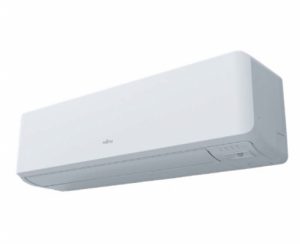A split system air conditioner consists of an outdoor unit coupled with an indoor unit, sometimes 100 feet away. But they are connected by underground cables and pipes, not typical air ducts used in most systems. This permits more efficient installation and requires less labour for maintenance than a standard air conditioning system. The indoor unit has its condenser and compressor, and some models also have a separate outdoor evaporator. These units can be installed in any room, although some require venting through the attic.
 Most split system air conditioners require a professional installation because they are difficult to install on your own. In addition, most experts recommend using a professional installer for this type of cooling because the interiors are usually poorly insulated and easily damaged. If you choose to perform the installation yourself, you need to use a good power washer to remove the exterior insulation. The evaporator unit can then be safely removed from the wall, often on its own, after removing the existing vents and pipes. Next, the electrical connections need to be spliced into new outlets, and the ceiling should be checked for proper vapour pressure.
Most split system air conditioners require a professional installation because they are difficult to install on your own. In addition, most experts recommend using a professional installer for this type of cooling because the interiors are usually poorly insulated and easily damaged. If you choose to perform the installation yourself, you need to use a good power washer to remove the exterior insulation. The evaporator unit can then be safely removed from the wall, often on its own, after removing the existing vents and pipes. Next, the electrical connections need to be spliced into new outlets, and the ceiling should be checked for proper vapour pressure.
Newer models of split system air conditioners incorporate high-efficiency condenser and compressor units. These models are called “high-efficiency” because they use less energy than older models. The result is more significant savings in operating costs, but many homeowners find that the initial installation is more complex than the past units. In addition, newer air conditioners feature a remote control, but many homeowners prefer to perform the installation themselves.
A split system air conditioner contains two primary components. One contains a refrigerant that is chilled before it is transferred into the evaporator. This refrigerant is cooled in the compressor. The compressor is powered by a gas such as Freon, and it is essential that the gas is not vented improperly, or refrigerants leak from the compressor can reach the evaporator and damage it.
An indoor unit is completely isolated from the exterior unit. When the indoor refrigerant reaches the evaporator, it is heated, warming the refrigerant to a freezing temperature. Next, a fan connected to the indoor unit blows the cooled air through the evaporator coil. The split system air conditioner then converts the warmed air back into the refrigerant, keeping it cold.
One of the significant benefits of the split system air conditioner model is that it can provide a dual-action cooling system for your home. It works well in conjunction with an air conditioner indoors. Most AC units are designed only to cool one part of the room at a time. The split system air conditioner can provide your entire home with cool air to help regulate the room temperature.
Another significant benefit is that split system air conditioners are easier to install than other types of cooling equipment. They require simple wiring connections to a grounded source. In addition, because the system does not use ducts or large fans, there is no need for underfloor heating, ductwork or ceiling heating. These units are also more energy-efficient than other types of cooling equipment. Because of this, they help lower your heating bills while providing you with the comfort and benefits of cooling in an eco-friendly manner.
